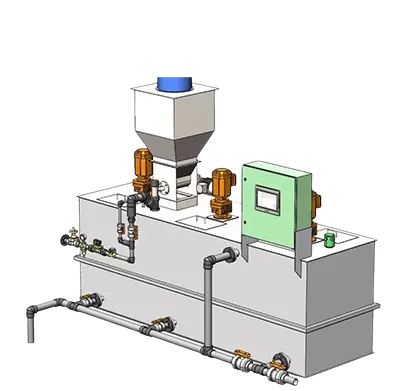In recent decades, wastewater treatment has become a serious environmental problem due to population growth, industrial development, and overall increases in water consumption. Municipal and industrial wastewater contains large amounts of organic matter, suspended particles, heavy metals, and chemical compounds. Untreated discharges into the environment can lead to water pollution and pose a threat to human health. Coagulants and composite materials are used to improve the efficiency of physical and chemical treatment processes. One of the most effective is cationic polyacrylamide ( CPAM ) .
What is cationic polyacrylamide?
Polyacrylamide (PAM) is a water-soluble synthetic polymer derived from the monomer acrylamide. By varying the type of functional groups in the polymer chain, various types of polyacrylamide can be produced, including anionic, nonionic, and cationic. Cationic polyacrylamides contain quaternary ammonium groups or secondary and tertiary amines in the polymer chain, thereby imparting a positive charge.
The positive charge in the structure of cationic polyacrylamide plays a key role in its effectiveness, as most suspended solids and organic compounds in wastewater are negatively charged and have a strong ability to attract positive charges. This property enables cationic polyacrylamide to effectively bind small suspended solids and form larger aggregates that can be easily separated from the wastewater.
Safety data sheet for polyacrylamide

Mechanism of action of cationic polyacrylamide in wastewater treatment
CPAM is based on three main mechanisms:
-
Charge neutralization:
Colloidal particles in wastewater repel each other and remain suspended due to their negative charge. When cationic polyacrylamide is added to the system, the positive charge neutralizes the negative charge of the particles, thus reducing the repulsive force between them. This causes the particles to move closer together and tend to stick together. -
Binding mechanism:
Long CPAM chains can bind multiple suspended particles . This phenomenon leads to the formation of larger, more stable aggregates that can be easily separated by sedimentation or filtration. -
Physical adsorption and coagulation:
The active groups of CPAM can bind to the surfaces of organic and inorganic particles via hydrogen bonds and van der Waals forces. These interactions improve coagulation and fluid purity.

Application of cationic polyacrylamide in wastewater treatment
1. Municipal wastewater treatment
In municipal wastewater treatment plants, CPAM is used as a coagulant during the coagulation phase. The addition of a small amount of this polymer can significantly improve the settling efficiency of suspended solids and reduce sludge formation. Furthermore, CPAM can improve the efficiency of filter presses and centrifuges in sludge drying plants.
2. Industrial wastewater treatment
Industries such as the petrochemical, paper, textile, steel, leather, dairy, and food industries often produce wastewater rich in organic matter and suspended particles. Cationic polyacrylamide effectively removes organic matter and dyes from such wastewater due to its positive charge. In many industries, cationic polyacrylamide is used in conjunction with polyaluminum chloride (PAC) or aluminum sulfate for simultaneous coagulation and agglomeration.
3. Concentration and drying of the sludge
Sludge drying is one of the most expensive steps in wastewater treatment. The CPAM system significantly reduces energy consumption and operating costs by increasing the settling rate of sludge particles and simplifying the drying process. Furthermore, the system’s dried sludge is typically smaller and easier to transport.

Advantages of using cationic polyacrylamide
-
Low dose, high efficacy:
The CPAM dose typically required is very low, but the effect is impressive. -
Improve the sedimentation rate and clarity of wastewater.
-
It can be used in a wide pH range (approx. 4 to 9).
-
Reduces sludge volume and improves water drying results.
-
Compatible with other chemicals such as polyaluminium chloride and lime.
-
Non-toxic and with high chemical stability.
Instructions for use and dosage
Cationic polyacrylamide is typically sold as a dry powder or ready-to-use solution. For industrial use, CPAM powder must be dissolved in water at the required concentration (typically 0.1% to 0.5%) before being added to wastewater. The exact dosage depends on the wastewater type, suspended solids concentration, pH, and ambient temperature, but is typically between 1 and 10 mg/L. The optimal dosage is best determined by a laboratory test prior to industrial application.
Factors influencing the efficiency of cationic polyacrylamide
-
Driving force: The more positive charges the CPAM structure contains, the greater its tendency to attract negatively charged particles.
-
Molecular weight of the polymer: Higher molecular weight polymers have stronger binding properties but may dissolve more slowly.
-
Wastewater pH and temperature: Optimum performance is achieved in the neutral pH range, with higher temperatures generally resulting in increased reaction rates.
-
Mixing time: Overmixing will result in lumps, so adjustments are necessary.
Safety and environmental tips
Cationic polyacrylamide is relatively safe at typical concentrations. However, it should be stored in a cool, dry place to avoid direct contact of the powder with skin and eyes. Free acrylamide monomer, if present, is toxic. Therefore, it is recommended to use certified products with a very low free monomer content (less than 0.05%).
From an environmental perspective, CPAM is a suitable option for wastewater treatment due to its low consumption, its relatively easy degradability in the environment and the lack of obvious destructive effects.
Finally
Cationic polyacrylamide is one of the most widely used and effective composite reagents in municipal and industrial wastewater treatment systems. Thanks to its charge neutralization, binding, and surface adsorption properties, this polymer rapidly removes suspended particles and organic compounds, thus improving wastewater clarity. Proper use of cationic polyacrylamide not only improves the quality of the treated water but also reduces operating costs and sludge formation. Therefore, many wastewater treatment plants and industrial facilities use this polymer as a key component in their treatment processes.